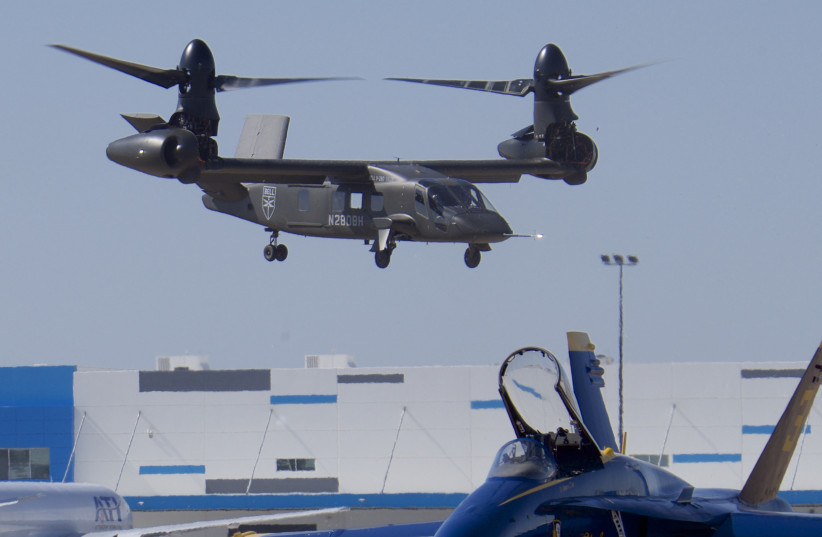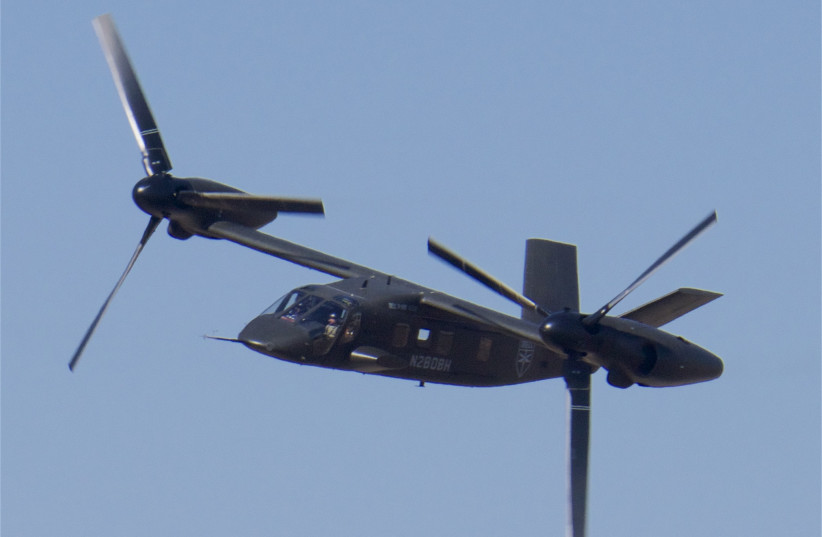by Seth J. Frantzman
Countries like Israel and other American partners, whether Japan or countries in the Gulf, all will want a new generation of helicopters.
 |
Bell V-280 Valor hover demo, 2019 Alliance Air Show
(photo credit: Wikimedia Commons)
|
The US Army said this week it had awarded the Future Long Range Assault Aircraft (FLRAA) contract to Bell Textron. This an important and major investment by the army in a new helicopter that will replace thousands of Blackhawks over time.
The army initiated this program back in 2019. It might have ramifications for US partners abroad and for what types of helicopters other countries will be acquiring in the future. Israel is one of those countries that needs new helicopters.
First let’s understand what the US procurement means for the helicopter industry and the future. “FLRAA will expand the depth of the battlefield by extending the reach of air assault missions and enabling ground forces to converge through decentralized operations at extended distances,” the army said. “FLRAA’s inherent reach and standoff capabilities will ensure mission success through tactical maneuver at operational and strategic distances.”
According to Defense News, “in a December 5 statement, Scott Donnelly, Textron’s chief executive, said the company is ‘honored that the US Army has selected the Bell V-280 Valor as its next-generation assault aircraft. We intend to honor that trust by building a truly remarkable and transformational weapon system to meet the Army’s mission requirements.’” The V-280 includes technology from a number of companies, including Israel Aerospace Industries.
The V-280 is a tiltrotor aircraft, meaning that it takes off like a helicopter but then the wings tilt and the rotors face forward, so it can cruise along like an aircraft. In terms of legacy and evolution, it looks like a V-22 Osprey, the Bell helicopter that first flew in 1989 and is used by the US Marines and US Air Force.

The V-22 can have a crew of four and take up to 24 troops, with up to 20,000 pounds of internal cargo and another 15,000 carried externally. It can also carry vehicles. The V-280 may be faster than the V-22 and have a longer range, but it will have less takeoff weight and carry less people. Where the V-22 can take some two dozen soldiers, the V-280 can handle only 14.
Compared to a Black Hawk, the V-280 will have a much longer range. Defense News noted that “the service wants FLRAA to be capable of traveling roughly 2,440 nautical miles (or 2,810 miles) without refueling, but also to be agile enough to maneuver troops into dangerous hot spots.” This would be a very long range in terms of capability for a helicopter.
So why should Israel care?
MEANWHILE, ISRAEL continues to have a helicopter problem. It has wanted to replace aging helicopters for many years. In late 2021, Jerusalem decided to purchase a dozen Lockheed Martin-Sikorsky heavy lift CH-53K King Stallions for the air force. Israel also flies the F-35 which is made by Lockheed Martin.
In addition, Rafael Advanced Defense Systems recently said it was teaming with Lockheed on laser air defenses based on Israel’s Iron Beam. Thus, the Israel connection and current work with Lockheed is impressive. The price tag for the CH-53s is also impressive at several billion dollars.
Israel currently operates UH-60 Black Hawks and Sikorsky CH-53s, the latter known in Israel as the Yasur. The Jewish state also has Apache attack helicopters. While its Black Hawks are more modern, Israel’s Yasurs are aging. Back in 2019, it had briefly grounded its fleet of Yasurs.
Around a decade ago, Israel was looking to improve its helicopter fleet and took a look at the V-22 Osprey. At the time, this cutting edge helicopter was becoming more mature as a platform and system that would enable Israel and other US partners to conduct unique missions.
Jerusalem came close to purchasing the V-22, but the agreement sat unsigned for years and became something of a long odyssey in the defense establishment. Meanwhile, Japan became the only foreign customer to acquire the V-22, receiving its first helicopter in 2020.
The V-22 isn’t the only case where Japan and Israel both expressed interest in a new American product, only to see Japan move forward and Israel prevaricate. Japan also purchased the KC-46 Pegasus refuelers, a plane that Israel also has finally procured, but which Israel waited years to finally make a decision. The billion-dollar deal for the KC-46As was signed earlier this year. Israel moving forward on these important procurement decisions has been one of the key legacies of Benny Gantz’s era at the Defense Ministry.
However, the V-22 issue has not moved forward. Back in 2020, Israel HaYom said that the defense establishment was putting the Osprey option back on the table. “After deciding several months ago to forego procuring the V-22 Osprey aircraft from US manufacturer Boeing due to budgetary restrictions, Defense Minister Benny Gantz and IDF Chief of Staff Lt.-Gen. Aviv Kohavi said they intend to reexamine the matter.” If Israel choses the V-22 it could be acquired relatively quickly.
Will Israel budge due to the US Army's decision?
It’s unclear now if the US Army’s decision on the V-280 might influence Israel to take another look at tiltrotor options for Israel’s helicopter fleet. These types of helicopters may be the wave of the future, not just for the US Army and Marines, but also for other services around the world. It’s not yet clear, however, which other US partners may be interested in these new futuristic helicopters.
The US is also considering a major contract for the Future Attack Reconnaissance Aircraft. Sikorsky and Bell have both presented their visions for a helicopter and the US Army is supposed to make a decision soon. By the end of the decade, these new futuristic helicopters should be in service. These decisions may also impact Israel’s choices regarding attack helicopters.
Countries like Israel and other American partners, whether Japan or countries in the Gulf, all will want a new generation of helicopters. These systems are costly, but the conflict in Ukraine is showing countries that they need to rapidly upgrade their systems to prepare for the next scenario. The era when countries could sit and relax with old models that date from the 1980s or 1990s is ending.
When it comes to helicopters, the US isn’t the only manufacturer – military helicopters are manufactured in Europe, South Korea and other places. The helicopter upgrade race is taking off.
Seth J. Frantzman
Source: https://www.jpost.com/israel-news/article-724368
No comments:
Post a Comment